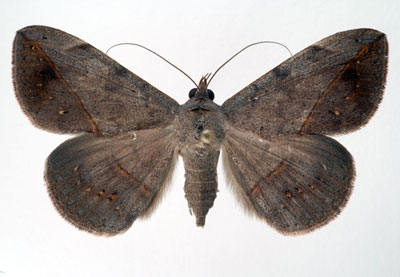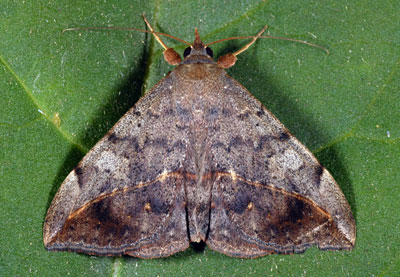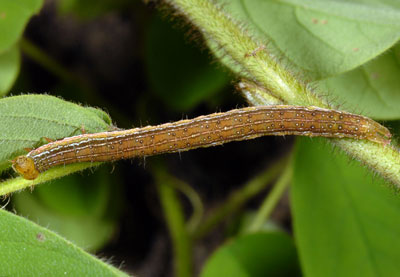
Velvetbean caterpillar
Anticarsia gemmatalis Hübner
(Insecta: Lepidoptera: Noctuidae)
Adult moths have grayish-brown bodies and a wing span of 30 to 38 mm. Wing coloration varies from ash grey to light brown to reddish brown. A dark orange line and a row of light spots extend across both wings. Eggs are oval, 2 mm long, white, and have a ribbed surface. Larvae grow to be 48 mm long, and their coloration varies considerably between instars. Pupae are brown, smooth, and 18 to 20 mm long.
During the summer, the life cycle is completed in about four weeks. Multiple generations may occur per year depending on the arrival time of migrating adults. Eggs are deposited on foliage, and larvae hatch within three to seven days. The six larval instars feed on foliage until the prepupal stage, which leaves the plant to pupate in the soil surface layer.
Native to the tropical and subtropical regions of the western hemisphere, velvetbean caterpillar was first reported in Florida in 1903. From tropical America, this species migrates northward every summer and causes severe problems in Florida, Georgia and Alabama.
Velvetbean caterpillar feeds predominantly on soybean and other legumes.
Images
To
save the Web-optimized images shown below to your hard drive:
PC users: right click to "Save Picture (or Image) As..."
Mac users: click and drag to your desktop.

Adult of velvetbean caterpillar, Anticarsia gemmatalis Hübner, with spread wings
(Photographer: Lyle Buss, University of Florida)

Adult of velvetbean caterpillar, Anticarsia gemmatalis Hübner, dorsal view
(Photographer: Lyle Buss, University of Florida)

Larva of velvetbean caterpillar, Anticarsia gemmatalis Hübner, dorsal view
(Photographer: Lyle Buss, University of Florida)

Larva of velvetbean caterpillar, Anticarsia gemmatalis Hübner, lateral view
(Photographer: Lyle Buss, University of Florida)